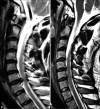Spontaneous regression of herniated cervical disc: A case report and literature review
- PMID: 33948312
- PMCID: PMC8088536
- DOI: 10.25259/SNI_142_2021
Spontaneous regression of herniated cervical disc: A case report and literature review
Abstract
Background: We have reviewed 75 cases plus our own single instance of spontaneous regression of herniated cervical discs.
Methods: We searched PubMed and EMBASE databases (until September 2020) utilizing the following keywords; "spontaneous regression," "herniated cervical disc," and "Magnetic Resonance Imaging (MRI) studies."
Results: In the literature, we found 75 cases of herniated cervical discs which spontaneously regressed; to this, we added our case. Patients averaged 40.95 years of age. Discs were paracentral or foraminal in 84% of the cases, with most occurring at the C5-C6 (51%) and C6-C7 (36%) levels. Symptoms included neck pain/radiculopathy (91%) or myelopathy (9%). The average interval between initial presentation and spontaneous regression of herniated discs on MRI was 9.15 months. Interestingly, on MRI, extruded/sequestrated discs were more likely to undergo spontaneous regression versus protruding discs.
Conclusion: Successive MRI studies documented the spontaneous regression of herniated cervical discs over an average of 9.15 months. Although this may prompt greater consideration for conservative treatment in younger patients without neurologic deficits, those with deficits should be considered for surgery.
Keywords: Extruded; Foraminal; Herniated cervical disc; Paracentral; Spontaneous regression.
Copyright: © 2021 Surgical Neurology International.
Conflict of interest statement
There are no conflicts of interest.
Figures






Similar articles
-
Spontaneous regression of herniated cervical disc.Spine J. 2003 Mar-Apr;3(2):171-3. doi: 10.1016/s1529-9430(02)00556-9. Spine J. 2003. PMID: 14589234 Review.
-
Spontaneous resorption of a large cervical herniated nucleus pulposus.Am J Orthop (Belle Mead NJ). 2014 Jul;43(7):E140-5. Am J Orthop (Belle Mead NJ). 2014. PMID: 25046190
-
Acupuncture and spontaneous regression of a radiculopathic cervical herniated disc.J Pharmacopuncture. 2012 Jun;15(2):36-9. doi: 10.3831/KPI.2012.15.2.036. J Pharmacopuncture. 2012. PMID: 25780641 Free PMC article.
-
Herniated cervical intervertebral discs spontaneously produce matrix metalloproteinases, nitric oxide, interleukin-6, and prostaglandin E2.Spine (Phila Pa 1976). 1995 Nov 15;20(22):2373-8. doi: 10.1097/00007632-199511001-00001. Spine (Phila Pa 1976). 1995. PMID: 8578386
-
Nursing review section of surgical neurology international: Evaluation of cervical disc disease and when surgery is warranted.Surg Neurol Int. 2017 Jul 7;8:136. doi: 10.4103/sni.sni_182_17. eCollection 2017. Surg Neurol Int. 2017. PMID: 28781913 Free PMC article. Review.
Cited by
-
The imaging of cervical spondylotic myeloradiculopathy.Skeletal Radiol. 2023 Dec;52(12):2341-2365. doi: 10.1007/s00256-023-04329-0. Epub 2023 Apr 18. Skeletal Radiol. 2023. PMID: 37071191 Review.
-
Unexpected Recovery: A Report on the Spontaneous Regression of a Herniated Cervical Disc.Cureus. 2023 Jul 5;15(7):e41429. doi: 10.7759/cureus.41429. eCollection 2023 Jul. Cureus. 2023. PMID: 37546141 Free PMC article.
References
-
- Autio RA, Karppinen J, Niinimäki J, Ojala R, Kurunlahti M, Haapea M, et al. Determinants of spontaneous resorption of intervertebral disc herniations. Spine (Phila Pa 1976) 2006;31:1247–52. - PubMed
-
- Burke JG, Watson RW, McCormack D, Dowling FE, Walsh MG, Fitzpatrick JM. Spontaneous production of monocyte chemoattractant protein-1 and interleukin-8 by the human lumbar intervertebral disc. Spine (Phila Pa 1976) 2002;27:1402–7. - PubMed
-
- Doita M, Kanatani T, Ozaki T, Matsui N, Kurosaka M, Yoshiya S. Influence of macrophage infiltration of herniated disc tissue on the production of matrix metalloproteinases leading to disc resorption. Spine (Phila Pa 1976) 2001;26:1522–7. - PubMed
-
- Gurkanlar D, Yucel E, Er U, Keskil S. Spontaneous regression of cervical disc herniations. Minim Invasive Neurosurg. 2006;49:179–83. - PubMed
Publication types
LinkOut - more resources
Full Text Sources
Other Literature Sources
Miscellaneous
